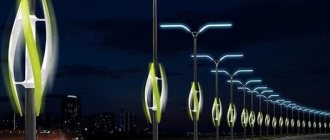Is it legal to charge for street lighting?
Is this a connection to our common house meter?
2) payment for street lighting? ANSWER: The amount of the fee and the list of services are subject to approval at the general meeting of owners. Whatever the owners decide, so it will be. No one has the right to impose services and prices on them. The price for “maintenance of outdoor lighting lamps” is intended for servicing free-standing lamps (those that are located on poles, and not on the entrances and walls of houses). According to the Rules for the provision of utility services to citizens, there is a utility service, but no. In order for the services related to the maintenance and repair by the owners of the property of an apartment building to be legitimate, the following condition must be met: the property must be part of the common property of the apartment building.
Standards for street lighting in rural areas
Standardization of street lighting In road tunnels, this indicator ranges from 50 to 750 lux and depends on the following factors;
- tunnel length;
- tunnel type (closed, having a wall with closed openings).
The requirements for open parking lots and fuel refueling places are as follows: they must have an average horizontal illumination level within 2 ÷ 10 lux. Attention LED street light sources The requirements and rules for choosing lamps for street lighting come down to the selection of a type of product that consumes little electricity, is resistant to climatic factors, has a long service life and, in addition, can be installed without problems. All these factors correspond to main LED luminaires.
Info
Who should perform routine maintenance? Which document should I use? More on this later. The principles of organizing street lighting in cities and rural areas are different, so it is technically impossible to hang a lantern on every pole along a rural street. Also relevant is the lack of money in the budget of a rural settlement to organize the maximum possible street lighting, which is annually developed by the administration and adopted by local deputies of the rural settlement (social activists who do not receive salaries).
Financing of rural settlements does not come through the administration of the district or even the region, but directly from the Federal budget. There are legislative acts regulating financing through interbudgetary transfers.
Attention
One of the most important is SNiP 23 – 05 – 95, which sets standards for outdoor lighting. For rural areas, the following rules apply:
- On main streets, as well as in the area of public buildings, illumination should be at least 4 lux.
- Street lighting of secondary streets and alleys can be half as much and amount to only 2 lux.
The same standard applies to driveways and village roads.
- If there is a question about roads in gardening and dacha cooperatives, then the standard of 2 lux also applies here. But it applies only to main roads. For secondary roads it is only 1 lux.
Note! If there are fire hydrants and other water sources on the streets in rural areas, they and the entrances to them must also be illuminated.
Important
Vladislav Tikhomirov / Tuesday, March 06, 2021 / Published in Articles Supports with two lamps You need to know that the most acceptable distance between poles for lighting and power lines is a distance of 35 meters. Secondary parameters when installing supports When installing poles for lighting, you need to know not only the distance between adjacent supports, but also how many meters there should be to elements of road and architectural significance along the entire length of streets, road surfaces and squares. Therefore, it is also necessary to take into account the prescribed standards in the regulatory documentation before planning the placement of lighting poles.
These standards include the following nuances:
- When installing poles along main roads, the distance from the pole to the curb should not be less than 1 meter.
For the installation of lamps on street areas, the main document is SNiP 23-05-95. It sets standards for street lighting and requirements for it. In addition, there are a number of industry standards that outline the basic requirements for lighting of transport highways, alleys, squares, park areas, historical monuments, etc.
We invite you to read: Caring for a pensioner over 80 years of age: how to apply for payment of benefits
These documents indicate the nuances of lighting specific objects that must be strictly followed when lighting them. Street lighting is carried out according to a specially developed project. It must be carried out by specialists who have a license, rights and the necessary permits, as well as having the appropriate qualifications to carry out such work.
N 1595, the Ministry of Energy of the Republic of Belarus DECIDES: 1. To approve the attached Standard Regulations on the procedure for carrying out organizational and technical measures for the overhaul maintenance of outdoor lighting networks in rural settlements. 2. This resolution comes into force on the day of its official publication.
Lighting standards in rural areas
Before starting work directly, you should familiarize yourself with the regulatory documentation on this issue. One of the most important is SNiP 23 – 05 – 95, which sets standards for outdoor lighting.
For rural areas, the following rules apply:
- On main streets, as well as in the area of public buildings, illumination should be at least 4 lux. The same standard applies to streets with residential buildings.
- Street lighting of secondary streets and alleys can be half as much and amount to only 2 lux. The same standard applies to driveways and village roads.
- If there is a question about roads in gardening and dacha cooperatives, then the norm of 2 lux also applies here. But it only applies to main roads. For secondary roads it is only 1 lux.
Note! If there are fire hydrants and other water sources on the streets in rural areas, they and the entrances to them must also be illuminated. The norm according to clause 7.37 of SNiP 23 – 05 – 95 is 1 lux.
Lighting standards depending on the object category
- A separate issue is the lighting of regional roads passing through populated areas. They must have lighting, which largely depends on the intensity of traffic. If during peak hours it exceeds a thousand cars per hour, then the road must have lighting of at least 15 lux. If the traffic intensity is lower, then the road should have lighting of at least 10 lux.
Street Lighting Law
Outdoor lighting control 13
3. Urban lighting control concepts 15
CONCLUSION 17
REFERENCES 18
APPLICATIONS………………………………………………………………………………..19
To the head of the administration of the Zadrypyshchensky urban settlement _____________________________________________ From ________________, residing at the address: Dear Sigismund Rudolfovich! For a long time, street ___________ (or the approaches to house No. ____ on street _______) in the village of ___________ are unlit at night. There are not a single street lamp or other artificial lighting near the house.
- Another aspect that should be taken into account is the need to install reactive power compensating devices when using discharge lamps. Typically these are cosine capacitors that are connected in parallel with the lamp.
Organize outdoor street lighting in populated areas “On the general principles of organizing local self-government in the Russian Federation”, issues of local importance of rural settlements include road activities in relation to highways of local importance within the boundaries of populated areas, as well as the exercise of other powers in the area. the use of highways and the implementation of road activities in accordance with the legislation of the Russian Federation; organization of street lighting. Clause 6 of Art. 13 Federal Law of November 8, 2007
In the countryside
The standards that street lighting in small rural areas must comply with are set out in the normative act of building codes and regulations, SNIP 23-05-95. According to standards, at least 8/10 of the entire village area must be illuminated.
For flashlights, metal halide lamps are most often used, which provide greater light output, but last only a year. LED technologies are especially relevant for rural areas, where it is difficult for service teams to travel due to the remote location. This type of flashlight has a long service life.
Norms
A network of lighting installations carries a potential danger, so many rules must be followed when installing it. For example, for overhead lines the wires must be insulated. These include different brands of self-supporting insulated wires, self-supporting insulated wires. The height of the lamp installed on cables depends on its location: on sidewalks - from 3 m in height, along the roadway - 6.5 m.
Service
The state finances the maintenance of lighting equipment, so it is the administration of the locality that takes care of it. She decides on the purchase of electrical equipment, installation or maintenance of lamps and, if necessary, enters into an agreement with companies that specialize in this work. Law No. 131-FZ stipulates that the local municipality bears financial responsibility, and the maintenance, installation of street lighting and its repair are carried out by the district energy sales department. The work is paid for either by the village administration or the organization that owns these communications.
Standards for street lighting in rural areas
Regulatory documents “SNIP 23−05−95. Natural and artificial lighting" and other standards regulate street lighting standards.
There are lesser-known documents that give an idea of what the level of illumination should be. Federal Law No. 131-FZ of October 6, 2003 is in force in the Russian Federation (as amended on July 21, 2007)
regulating the responsibility of the authorities for street lighting on the territory of the municipality. The illumination values recommended by the standards are operational values, below which the illumination should not be at any time during operation.
In this case, the distance from the lamp to the support itself should be at least 40 cm.
- If lamps are installed on building facades, the minimum installation height is 2.5 meters. In this case, lamps for voltages up to 380V can be used with their protection level not lower than IP
- As for the wire for lighting, for overhead lines it should be an insulated wire.
Typically, various brands of SIP are used for this. Bare wire may only be used as an exception and with appropriate justification.
Using insulated wire for lighting network
- If non-insulated wires are used, it is extremely important to observe the alternation of wires. According to clause
Street lighting standards in rural areas
In such territories, all issues are resolved between residents and the farmer (owner or tenant) without any outside interference.
In such a situation, in order to transfer the energy networks to the balance of the municipality (something similar to deprivatization), you will have to go through several circles of bureaucratic hell.
And this is only possible after bringing the energy system (for a long time considered de facto ownerless) into complete order.
The service life of the lamp in a rustic street lighting lamp is approximately 1.5 years under average operating conditions: 12 hours on, 12 hours off.
Smolensk power engineers answered questions about street lighting
If there is no light on the street... The most common problem for residents of the Smolensk region is the question “Where should you go if there is no light on the street?” We clarify that in accordance with Art. 14 Federal Law of October 6, 2003 N 131-FZ
(adopted by the State Duma of the Federal Assembly of the Russian Federation on September 16, 2003) the organization of street lighting is an issue of local importance for the settlement.
On approval of the departmental target program “Street lighting in 2021” (as amended on August 17, 2021) In accordance with the decision of the Engels City Council of Deputies dated November 27, 2013 N63/01 “On the powers of the executive and administrative body of local self-government, performing the functions and powers of the local administration of the municipal formation of the city of Engels, Engels municipal district of the Saratov region", the Procedure for the development, formation and implementation of municipal and departmental target programs in the Engels municipal district, approved by resolution of the administration of the Engels municipal district of April 6, 2010 N 2105.
Are there any street lighting standards in rural areas?
Section 7. Electrical equipment of special installations. Chapters 7.1, 7.2″ (approved by the Ministry of Fuel and Energy of the Russian Federation on 10/06/1999) Chapter 6.3. OUTDOOR LIGHTING The document is available: from 20 to 24 hours (weekends, holidays - 24 hours) “GOST R 50597-93. State standard of the Russian Federation. Highways and streets. Requirements for operational condition acceptable under the conditions of ensuring road safety" (approved by Resolution of the State Standard of Russia dated October 11, 1993 N 221)
To calculate illumination, a lot of indicators are used, such as: category of illuminated roads and streets (SNiP 2.07.01.), type of road surface, geographical location of the settlement, brightness of the surface, traffic intensity. There are also fixed indicators of illumination of individual objects and other standards, for example
Dima Nikitenko March 15, 2010, 14:45 Expert's answer Lighting of streets within rural and urban settlements is the responsibility of the administration of a rural settlement. Lighting of federal or regional highways passing through a rural settlement is the responsibility of state authorities of the Russian Federation and a constituent entity of the Russian Federation, respectively.
We invite you to read: New law on who does not pay child support
And the lighting of other roads outside the boundaries of a populated area is a matter of local importance, carried out by district administrations. The obligation of the village administration to conclude an agreement for the installation of poles, the installation of lighting fixtures, and to conclude an agreement with the electricity supply organization for the supply of electricity follows from clause.
Absolutely zero on this issue. Has anyone already encountered this problem and can suggest ways to solve it? There are light bulbs on the entrances, but they illuminate the area only near the entrance; one of the houses has a lantern hung on the wall, but it also illuminates only near the entrance within a radius of 5-7 meters; the playground remains in the dark.
And anyway, what kind of thing is this about hanging a lantern on the wall of a house? So that it shines through everyone’s windows. Maybe Anko knows something, seems to be a similar topic. Like Dislike Any 05/15/2014 Ser Jon (05/15/2014 - 11:34) wrote: Maybe Anko knows something, seems to be a similar topic. I think this: if the territory of the house is demarcated, then the lighting on it is different the owners' account, if not, then you probably need to communicate with the city's urban development department.
Content
Street lighting in rural areas law
This article describes in detail the law about street lighting in rural areas, and everything you need to know about it.
Currently in Russia, most small settlements do not have the proper level of street lighting. This makes life difficult for local residents, especially in the winter.
Responsibilities for street lighting fall on municipal authorities. But, as a rule, they do not provide rural settlements with the proper level of lighting.
What to do in such a situation and where to go for citizens to protect their rights.
Who should provide street lighting in rural areas?
Street lighting in rural areas is carried out on the basis of SNIP 23−05−95.
In rural areas, this obligation is assigned to local authorities, that is, local government.
The head of the village council is obliged to properly ensure the timely supply of electricity to illuminate rural streets.
This rule is described in article of federal law number 131 adopted in 2003. The latest changes came into force in 2018.
Thus, the chairman of the village council must organize the supply of electricity, as well as launch proper lighting on the streets of villages.
Legislative regulation of the duties of municipal heads
The lighting of rural streets is regulated at the legislative level on the basis of federal law number 131, amended in 2021.
The improvement of territories is entrusted to municipal authorities. The chairman of the village council is obliged:
- Ensure the maintenance of public areas;
- Ensure the maintenance of houses and house facades;
- Draw up projects aimed at repairing buildings and structures of public importance;
- Ensure the organization of street lighting and building lighting;
- Ensure landscaping of areas owned by the municipality;
- Provide the population with the proper level of information by posting notices on special boards;
- Ensure that the population is informed about streets and houses by designing appropriate signs and numbers;
- Providing the territories of rural settlements with sidewalk paths;
- Ensuring waste removal and cleaning of owned areas;
- Ensuring celebrations;
- Ensuring the organization of cleaning activities with the help of the population of a rural settlement.
According to social standards, the streets of a rural settlement should be 80 percent illuminated.
That is, several streets or part of the streets may not be properly lit.
This rule is applicable for streets where there are not many residents, and their use is carried out in a reduced size.
Special cases of rural street lighting
The lighting of rural streets is the responsibility of local governments. It is a fact. But do they have the ability to properly ensure this obligation?
Currently, very little funds are allocated from the budget for rural authorities to carry out their activities related to servicing the territories under their jurisdiction.
Often they simply do not have enough to pay the costs of maintaining electrical networks.
In addition, electricity consumption in winter is very high and they do not have enough to pay for the electricity consumed.
Therefore, local authorities decide to alienate some territories. That is, not all the streets of the village are properly illuminated, and the supply of light occurs at a certain time.
There were cases when the court made a decision on the need to provide a village with lighting, but the village authorities could not implement its decision due to lack of funds. To solve this problem, rural authorities need to rationally use the provided budget funds. In addition, when creating an application for the allocation of funds from the budget, it is necessary to correctly calculate all future expenses, taking into account the increase in the cost of paying them. Otherwise, there won’t be enough money again.
Thus, everything depends on the correctness of the actions of the head of the village council. If he is interested in the development of his settlement, then he will find funds with which he can properly provide lighting to all the streets of the village.
What to do if there is no light in the village
If the streets of a rural settlement are not equipped with proper lighting, then residents have the right to file a complaint with the local government authority. If no action is taken, then they have the right to file a complaint with the prosecutor’s office, as well as with the court.
When filing a complaint, you must refer to federal law number 131, adopted in 2003, amended in 2021, as well as SNIP 23−05−95.
The court and prosecutor's office of the Russian Federation, if they find violations of the rules for providing rural settlements with communications, will make a decision on the mandatory fulfillment of obligations.
In some cases, there is no need to hope that local authorities will immediately begin to implement the court decision. It is quite possible that they simply do not have enough funds. Therefore, the question of lighting rural streets remains open.
In this article you learned about the law about street lighting in rural areas.
If you have any questions or problems that require the participation of lawyers, then you can seek help from the specialists of the Sherlock information and legal portal. Just leave it on our website.
Are there any street lighting standards in rural areas?
CONCLUSION 17
Lighting city streets was initially the concern of the management structures of settlements, and the history of the organization of street lighting testifies to the systematic efforts of government agencies and technical specialists to increase its efficiency and economy.
It all started in China and Mesopotamia, where natural gas was supplied to temples through bamboo pipes and lit on special occasions. Then, more than two thousand years ago, bright bonfires from the branches of resinous trees were lit at night in the squares of ancient Athens. Special people were assigned to them to monitor the fire.
Then there was Ancient Rome with torches attached to the walls of buildings and oil lamps, Egypt, Assyria and Babylon... The narrow crooked streets of Grenada, the capital of the last Arab caliphate in the 14th century, were already well illuminated by lanterns with oil pans. But all this was somehow disordered and irregular.
In Paris, by decree of Parliament in 1558, it was ordered to light pots of tar on the corner of every street from 10 pm to 4 am. In fact, this is the first mention of a street lighting system with a specified operating mode.
The first comprehensive system of urban street lighting was created in the 17th century in Amsterdam, on the initiative of Jan van der Heijden, who was primarily known as the organizer of the city fire department. In 1668, he proposed installing street lights to prevent citizens from falling into canals at night, to combat crime and to make it easier to fight fires.
Van der Heyden lamps were used in Amsterdam until 1840, after which they were replaced by more modern lamps. Very soon other cities borrowed the Amsterdam innovation. In 1682, the city of Groningen ordered 300 lanterns of Van der Heyden's design. In the same year, urban lighting of the Van der Heijden system was introduced in Berlin.
In Russia, street lamps appeared under Peter I - in 1706 in the then capital - St. Petersburg, on the facades of some houses near the Peter and Paul Fortress. The first stationary lamps appeared on the streets of St. Petersburg in 1718. Regular street lighting was introduced in 1723 in St. Petersburg, when, thanks to the efforts of Chief of Police General Anton Divier, 595 lamps were lit on the most famous streets of the city.
Lighting the northern capital was a profitable business, and merchants were willing to do it. They received a bonus for each burning lantern and therefore the number of lanterns in the city began to increase. In 1770, the first lantern team of 100 people was created. (recruits), in 1808 she was assigned to the police. So, by 1794, there were already 3,400 lanterns in the city, much more than in any European capital.
The use of kerosene made it possible to significantly increase the brightness of lighting. Gas lamps appeared at the beginning of the 19th century. Their inventor was the Englishman William Murdoch. In 1807, lanterns of a new design were installed on Pall Mall and soon conquered all European capitals.
In 1819, gas lamps appeared in Russia, and in 1835 the St. Petersburg Gas Lighting Society was created. Spirit lamps appeared in 1849.
In 1863, the widespread installation of kerosene lighting began in Moscow, and within three years 6,400 kerosene lanterns were lit in the city.
At the end of the 19th century, with the invention of electricity and the electric lamp, gas lanterns were replaced by lanterns with electric lamps. In 1879, 12 electric lights were lit on the new Liteiny Bridge. “Candles” by P.N. Yablochkov were installed on lamps made according to the design of the architect Ts.A. Kavos.
In 1880, the first electric lamps appeared in Moscow. On May 15, 1883, on the day of the coronation of Alexander III, the area around the Cathedral of Christ the Savior was illuminated using arc lamps. At the same time, the first electric illumination of the Ivan the Great bell tower was installed. For this purpose, 3,500 T.A. Edison incandescent light bulbs were purchased.
Thus began the era of lighting cities using electricity.
The organization of street (external) lighting and the installation of signs with street names and house numbers on the territory of the city is carried out in accordance with the Federal Law of October 6, 2003 N 131-FZ “On the general principles of the organization of local self-government in the Russian Federation”; Federal Law of July 21.
2005 N 94-FZ “On placing orders for the supply of goods, performance of work, provision of services for state and municipal needs”; Instructions for the operation of outdoor lighting installations in cities, towns and rural settlements, approved by order of the Ministry of Housing and Utilities of the RSFSR dated May 12, 1988 N 120;
We invite you to familiarize yourself with: The law on payment for land is in force
Objects (means) of external lighting - outdoor lighting devices (lamps, spotlights), which can be installed on streets, squares, underground pedestrian crossings, in transport tunnels, on supports specially designed for such lighting, supports of the contact network of electrified urban transport, walls , floors of buildings and structures, parapets, fencing of bridges and transport overpasses, on metal, reinforced concrete and other structures of buildings and structures and in other public places.
Street lighting is an artificial means of optically increasing visibility on the street at night; as a rule, it is carried out by lamps mounted on lighting masts, overpasses and other supports. The lamps are turned on at night either automatically or manually from the control room.
Reflective lighting is used to illuminate highways, ring roads and major highways. Each lantern is equipped with a reflector; The power of the lamp installed in the lantern is 200-250 watts.
To illuminate secondary roads, both reflective and diffuse lighting can be used. The lanterns are equipped with a raised transparent shade that scatters the rays over a long distance. The power of the lamps is 100-190 watts.
Diffused lighting is used to illuminate pedestrian sidewalks, parks, forests, bicycle paths and public transport stops. When designing such lanterns, special attention is paid to the lampshade, which scatters the rays. They are usually made either in the shape of a ball or in the shape of a cylinder. For greater scattering of light rays, transparent rings with a relief shape are installed on cylindrical lampshades. The power of the lamps used in such lanterns is 40-100 watts, depending on the distance at which the lanterns are installed from each other.
Street is a named urban planning object that provides transport and pedestrian connections between residential areas, as well as between residential areas and industrial zones, public centers, blocks, having linear fixed boundaries along the entire length, beginning and ending.
License plate - a plate with the serial number of the building.
Street sign - name plate (assigned name).
House sign is a sign that simultaneously indicates the serial number of the building and the name of the street, alley, square, etc.
The installation of street lighting is regulated by VSN 22–75 - “Instructions for the design of outdoor lighting in cities, urban-type settlements and rural settlements.” According to the nature of the requirements for lighting, all streets and squares of cities are divided into three categories: A - expressways, highways of citywide importance, etc.;
Unlike all other lighting installations, the level of illumination for roads with asphalt concrete pavement is standardized not by the amount of illumination, but by the amount of brightness of the road surface in the direction of the observer located on the axis of traffic movement. This is explained by the fact that asphalt, especially wet, has a pronounced specular nature of reflection, as a result of which the amount of illumination can characterize visibility.
For streets and roads that have the simplest (dirt, crushed stone) or transitional type (asphalt, reinforced with binders) surfaces, it is permissible to characterize the level of illumination by the magnitude of illumination. Therefore, VSN 22–75 establishes the standard for lighting streets and other passages with asphalt concrete pavement in the form of an average brightness value (ranging from 1.6 to 0.2 cd/m2) depending on the category of streets and traffic density, and for streets with the simplest transition type of coatings - in the form of the average horizontal illumination value (ranging from 6 to 2 lux).
To illuminate streets and roads, it is recommended to use mainly gas-discharge light sources. Currently, DRL lamps are most widely used in this area. Fluorescent lamps are rarely used, mainly in small southern resort towns where high brightness is not required.
The operation of fluorescent lamps in northern cities in winter is difficult. In foreign practice, backgammon with DRL lamps uses low and high pressure sodium lamps quite widely. In Moscow and some other cities, DKsT xenon lamps are used to illuminate squares. Incandescent lamps are currently used only in villages or on local city streets;
the use of these lamps will gradually decline due to their low efficiency. The following luminaires are currently widely used for street lighting: RKU - street cantilever; RSU – outdoor suspended; ISU – outdoor with halogen incandescent lamp; SPPR – suspended prismatic; SVR – crowning;
RBU – wall-mounted. The most common way to install street lamps is on special supports or on trolleybus network supports. It is rational to use cable braces between houses for hanging lamps, but this technique is mainly suitable for brick buildings; panel houses are usually not designed to install guy wires.
Standards for street lighting
Lighting in the city is divided into two important components - light in the area of highways and lighting of areas for pedestrians. According to the law, the standards for them are different, collected in SNiP 05/23/95.
Road lighting
The road lighting system is the most important, because without its organization, maintaining road safety is impossible. Factors that affect illumination:
- Intensity of road use. Over the course of an hour, an unequal number of cars travel along different roads, depending on which the transport routes are divided into four categories: highways (highways) with traffic from 3000 cars/hour, highways (1000 - 3000 cars), roads (500 - 1000 cars) , roads with low traffic (less than 500 cars).
- Allowed speed of use. So, in a village or other populated area you are allowed to move slower than on a highway. To maintain distance between cars, highways need to be illuminated more intensely.
- The significance of the street. Main streets in cities, central streets in villages or historical squares are always more powerfully illuminated.
Based on GOST and SNiPs, there are strictly established illumination standards, which vary from 4 to 20 lux or more. For streets and roads of local importance, an average horizontal illumination of 4 - 6 Lx is sufficient, for main streets of regional importance - 10 - 15 Lx, for public streets of citywide importance - 15 - 20 Lx. When crossing a highway and a small road in the intersection area, the light should be as bright as on the main street.
The standard sets the average brightness of the coating: interval 0.2 – 1.6 cd/sq. m. Within the city, this figure cannot be less than 1.6 cd/sq. m, only at the entrances to the airport and other ports - 0.8 cd/sq. m.
Cars are involved in maintaining good street lighting. To prevent the headlights from disturbing other drivers, the latter are responsible for timely switching the position of the headlights (from low beam to high beam and vice versa). A number of cars even use AFS - an adaptive lighting system, where the computer itself is responsible for switching the lights.
Lighting standards for pedestrian areas
The arrangement of places for pedestrian movement is organized according to a different principle. Typically, the requirements for illumination of an area are interconnected with the type, size of the settlement, and the significance of the street itself.
Where transition zones are adjacent to central streets and highways, lighting is installed at a level of 10 Lux. For streets located far from highways, lighting of 4 lux is allowed, for local streets (for example, in the private sector) - 2 lux.
Landing areas where people board public transport should be intensively illuminated (10 lux). A similar level of illumination is provided in children's playgrounds with equipment for outdoor games. The brightest light is installed in pedestrian tunnels (50 - 100 Lux).
Lighting standards for other functional areas and recreation areas:
- stadiums – 6 – 10 Lx;
- central entrances of city parks - 6 Lux;
- central alleys of parks - 4 lux;
- side alleys of parks - 2 Lux;
- areas at the entrance to cinemas, variety areas - 10 Lx;
- exhibitions - 20 Lk.
Street lighting in rural areas
The installation of light sources in a village, town or other type of rural area is regulated by current legislation. SNiP 05/23/95 has a special section that addresses this issue. The responsibility to monitor the correct implementation of lighting lies with local authorities, which ensure the timely supply of electricity during the dark period of the day.
According to social standards, streets in rural areas should be illuminated by 80%, that is, the absence of lighting is acceptable on a number of streets where there is a small population or their use is not intensive.
Regarding specific numbers, they relate to the average horizontal illumination and are measured in lux (Lx):
- main street, shopping center sites - 4 lux;
- minor streets, alleys, village roads - 2 Lk.
The illumination level on the main streets of dacha associations and cooperatives should be within 2 Lux.











